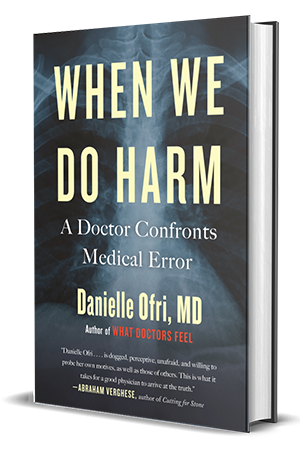“Medium” review of “When We Do Harm”
by Miriam Diaz-Gilbert
Medium
Have you experienced a medical error? Have you been harmed by a medical error? Do you know someone who is permanently harmed or has died as a result of a medical error?
In her latest book, When We Do Harm: A Doctor Confronts Medical Error, attending physician at Bellevue Hospital and professor at NYU Medical School, Danielle Ofri presents eye-opening research and interviews with scholars and experts that focus on studies that investigate the cause of medical errors, the shortcomings of EMRs (electronic medical records), and missed diagnoses.
Ofri also discusses bias in hospital care and treatment, resident work hours, nurse work conditions, and why it’s so hard to file medical malpractice lawsuits.
When We Do Harm shows how medical errors committed by well intentioned and mostly compassionate doctors, medical students, residents, and nurses unintentionally turn some patient’s lives upside down or cause their death.
Two real patient cases in When We Do Harm include the hospital horror that Jay and Glenn suffered.
Ofri writes compellingly about the ordeal that Jay, a leukemia patient, endures as a result of several poor decisions and errors committed by the medical and nursing team and witnessed by his helpless wife, an emergency room nurse.
The ordeal Glenn, a burn victim, endures and the nightmare that his wife and daughter are left with for years to comes is just as shocking.
The chapters on Jay and Glenn are gripping and read like a thriller. Both of these patient stories as a result of medical errors left me in tears.
Through thorough research, interviews, and patient accounts, Ofri illustrates what can and does go wrong when technology and poor communication among medical and nursing staff succeed in harming patients and worse, ending their lives.
Some medical errors result in death. Other medical errors do not result in death but cause harm because they result in a misdiagnosis or a delayed diagnosis.
Ofri is also candid about her medical errors.
When she was a resident, she botched a diagnosis. She was ready to send a patient home when another doctor pointed out that the CT scan she failed to read indicated the patient had an intracranial bleed. He was rushed to the OR to have the bleed drained.
Thirteen years later Ofri commits another medical error. In chapter three — Making — or Missing — the Diagnosis, Ofri shares her misdiagnosis of a patient. She missed 69 year-old Ms. Romero’s multiple myeloma diagnosis.
Ofri writes, “Ms. Romero’s case has haunted me over the years. For doctors and nurses it’s devastating to have missed a serious diagnosis, and agonizing to contemplate the additional stress you’ve caused your patient….â€
This intriguing and jaw-dropping seventeen chapter book, written in a reader-friendly and conversational style, will leave you stunned, angry, and in tears.
When We Do Harm will resonate with those who have suffered and survived a medical error and lived to talk about it, and with those who have lost loved ones to a medical error that could have been prevented.
Ofri points out that medical errors cause death but adverse affects caused by errors are more prevalent and need to be addressed. I can attest to that.
I survived a transected left ureter caused by a botched laparoscopic hysterectomy, surgery to unkink a small bowel obstruction, and a left kidney nephrostomy as a consequence. This was followed by successful surgery to repair my ureter. That sepsis did not take me is a miracle.
Ofri points out that “having a basic info sheet on hand for any medical encounter can help prevent basic medical errors like prescribing something you are allergic to….†However, this effort on the patient’s part may fail.
During my collective 26 day hospital stay I was almost given CT scan dye even though I am severely allergic to CT scan dye— I go into anaphylactic shock.
My husband, my patient advocate, was with me. He stopped the tech from giving me the CT scan dye and insisted she read my patient chart in front of her for my allergies.
I was also injected with Lasix even though I am allergic to sulfa. Violently jerking my body and screaming at the top of my lungs, “I’m on fire. I’m burning. I’m dying,†failed to convince the nurse that I was having a severe allergic reaction.
My husband could only watch in helpless horror as he listened to my blood curling screams while the nurse climbed on top of me to hold me down me down and empty the Lasix injection into my vein.
No one read my patient chart, my EMR (electronic medical record) listing all my drug allergies — not the doctor who ordered the Lasix, not the hospital pharmacist who dispensed it, and not the nurse who administered it.
To add insult to injury, I did not have a medical malpractice case. For reasons thoroughly explained by Ofri in chapter 11 — I’ll See You in Court — I understand now why three top medical malpractice attorneys told me I had no case.
Medical errors occur every day. Patients are harmed. Those who survive the error are left with damage in the form of physical and emotional scars, and with the trauma of almost having died at the hands of those who pledge to “first do no harm.â€
Inspired by a 2016 article Ofri read in the British Medical Journal (BMJ) suggesting that the third leading cause of death in the US is medical error, When We Do Harm contains a notes section listing scholarly sources for further reading, and an index.
Ofri writes, “Healthcare is an imperfect system. Healthcare is a human endeavor. Patients need to be alert and skeptical.â€
She also writes, “Doctors need to openly acknowledge error and apologize directly to patients.â€
This book is a must read for anyone entering a hospital as a patient, and for family members and patient advocates. Doctors, nurses, and hospital administrators will also benefit. It should be required reading in nursing and medical schools.
When We Do Harm: A Doctor Confronts Medical Error lays out the downside of medical care, calls for a cultural shift to protect patient safety and reduce harm caused by medical error, and suggests ways to do so.









